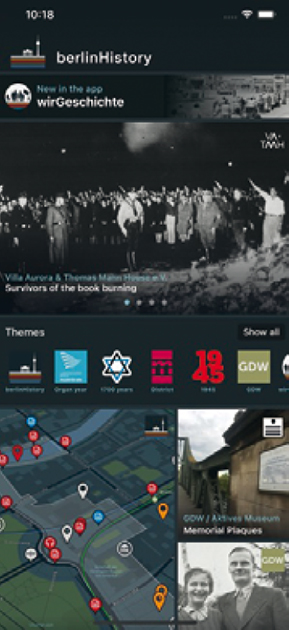Developing tourism to remembrance sites
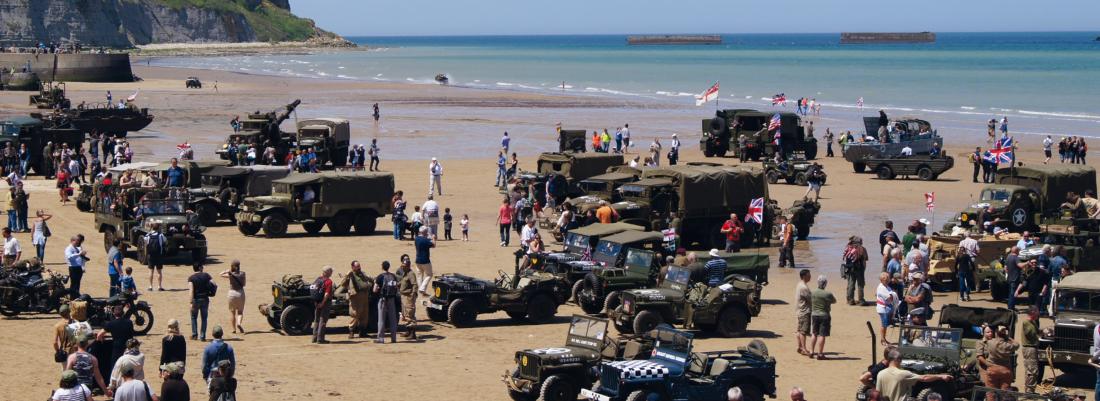
Remembrance sites in France are seeing an unprecedented rise in visitor numbers, driven by recent improvement works to mark the anniversaries of the two world wars. This tourism development differs significantly from Germany, where managing the traces of the recent past raises countless questions.
Tourism to the D-Day landing beaches in Normandy and the First World War sites in northern and eastern France has witnessed considerable growth in recent years. The popularity of contemporary conflict sites is linked to a renewal of remembrance and new displays, encouraged in France by the State and local authorities.
Even before the end of the First World War, there was a move to turn the traces of the conflict into heritage. A Committee for Wartime Ruins and Remembrance, chaired by architect André Ventre, drew up an inventory of notable sites to be preserved: trenches, firing platforms, bunkers, shelters, chambers, etc. The goal was to safeguard and pass down a selection of “these tragic souvenirs to future generations”. The first guidebooks were published to take “tourists” around the battlefields to discover the ruins. In 1917, the Michelin brothers published their first Guide Bleu to the battlefields, going on to produce a whole series of guidebooks that extended to other fronts and went on until the late 1920s, selling nearly two million copies. So began, as in other places along the former front, what is known in France as “remembrance tourism”.
In 1921, the families of French soldiers killed in the war were entitled to one free journey by train per year to visit the burial place of their loved one. From the end of the war, veterans, widows and orphans performing their private pilgrimages coexisted with organised tours for the many curious who wanted to see the ruins for themselves. Among them were many foreigners, in particular British and Americans. The Germans were not absent from the pilgrimages to the Western Front in the wake of the Great War, though it was not until the early 1930s that the Volksbund Deutsche Kriegsgräberfürsorge, an organisation set up in 1919, began taking parties of veterans and travellers to France, often taking in Paris and its monuments as well.
These pilgrimages were interrupted by the Second World War, but with the 50th anniversary of the First World War came a move towards the setting-up of museums, one notable example being the Verdun Memorial, which opened in 1967. This was a time when the veterans of 1914-18 wanted to leave their own accounts and messages on the actual sites of the fighting. After a long period of decline in wartime remembrance in France over the 1970s and 1980s, the notion of “remembrance tourism” crystallised in the 1990s, when a gradual shift took place from “pilgrimage” tourism to “history” tourism, especially around the First World War sites. This transformation occurred as the last surviving veterans gradually died out, bringing a profound change in the nature of the travel practices and motivations of visitors. It would seem opportune to look again at this change through the recent example of the First World War centenary.
The centenary watershed
The First World War centenary was marked by unprecedented investment from local authorities on the former front to renew the remembrance offering, in partnership with the State. Many museums and sites were renovated, and many new visitor sites were opened. November 2014 saw the official opening of the Ring of Remembrance near the cemetery of Notre Dame de Lorette which bears the engraved names of the 580 000 soldiers of all nationalities who died across the departments of Nord and Pas-de-Calais. Today it is adjacent to the new Lens 14-18 (2015), interpretation centre (2015), whose name recalls the nearby presence of the Louvre-Lens museum, part of an effort to make Lens a cultural and tourism destination. The Musée-territoire 14-18 (2014) , in the Oise, is an open-air museum to present the department’s First World War heritage, filling a gap between the major sites of the Somme and the Aisne. The renovation of the Verdun Memorial (2016), with its new displays, and the creation of a “public cultural cooperation establishment” (EPCC), means that all of the Meuse’s remembrance heritage can now be promoted, including the forts of Vaux and Douaumont in its tourism offering. In view of the numbers of British visitors, the Historial de Péronne completely renovated its satellite site in Thiepval (2016), including a fresco by artist Joe Sacco. In terms of Franco-German remembrance, the inauguration of the Franco-German Memorial on the Hartmannsvillerkopf (2018) put Alsace once again among the key sites of First World War remembrance, in step with the development of tourism along the former front line of the Vosges mountains. Finally, the creation of a Chemin des Dames Visitors’ Centre at the Dragon's Cave (2019) represents the culmination of a strategy with a clear focus on receiving tourists to the entire battlefield.
The areas surrounding all of these sites also saw the growth of an open-air offering during the centenary, made up of battlefield and remembrance trails, driven by the publication of a large number of tourist maps and guides. These include updated editions of the Michelin battlefield guides, with commentary, in paper and e-book format, a Guide du Routard entitled The Great War 14-18: remembrance trails, IGN maps of the main sectors of the front, not to mention hundreds of brochures published by the different tourist offices between 2014 and 2018.
The centenary served to consolidate the creation of genuine tourist destinations linked to the memory of contemporary conflicts, driven by the development of e-tourism. This phenomenon is also found to be very present in Normandy, around the landing beaches. Thus, the development of remembrance followed a hybridisation of practices, as a direct result of local organisations investing in the internet. Social media and even YouTubers are now widely used to attract more and more visitors. These include large numbers of individuals in search of their own family histories, as well as history fans and enthusiasts of green tourism geared to nature and the landscape or the discovery of local heritage. Another trend has been the amalgamation of historical periods, as at the Musée Guerre et Paix en Ardennes (2018), which covers everything from the Franco-Prussian War to the Second World War. The development of tourism also involves networking between remembrance tourism operators, with the “First World War Centenary” and “Remembrance Tourism in Normandy” destination agreements – an initiative of the French tourism development agency, Atout France – the Mém’Histo network for regional cooperation between the contemporary history museums of Hauts-de-France, and the Museums and Memorials of Contemporary Conflicts (MMCC) network, run by the Ministry of the Armed Forces.
Lastly, developing tourism at these remembrance sites means adapting to the use of new digital practices in situ. The revival of interest during the First World War centenary was also driven by efforts at modernisation made by local authorities with support from the State. For instance, the Verdun Memorial introduced an immersive tour, touchscreen terminals and now 3D glasses, while the Australian John Monash Center in Villers-Bretonneux (2018) and the Dragon’s Cave (2019) introduced a fully immersive display and large interactive tables that give visitors a better understanding of the surrounding sites. During the centenary, too, a great many sites began offering multilingual visitor services, with information panels translated or summarised in several languages, multilingual audioguides and guided tours in English, German and Dutch.
In Germany, civicism rather than remembrance tourism
The military cemeteries, monuments and buildings linked to the First World War, although they are still numerous, have not received the same attention in Germany, where the memory of the First World War has long since dispersed into that of the Second World War. Since 1952, for instance, the Day of National Mourning has remembered the “victims” of both the First and the Second World Wars. If the notion of remembrance tourism is now institutionalised in France, that is not the case across the Rhine, where tourism (associated with leisure) and remembrance (associated with culture, mourning and education) are treated quite separately. Ethical and moral questions have an important place in the public debate when it comes to developing a remembrance site. Yet remembrance tourism raises questions for the tourism industry in Germany today. The concept of “dark tourism” to locations associated with war, catastrophe or genocide is often emphasised to criticise the use of remembrance for commercial purposes.
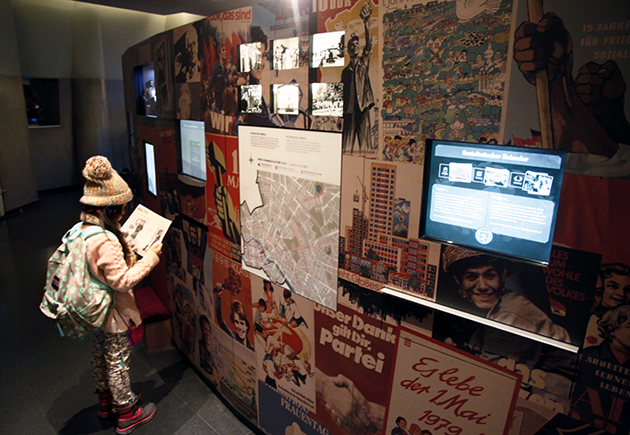
A child visits the DDR Museum, Berlin. © Franck Viltart
Remembrance tourism as a means of attracting more visitors would seem not to mix with the German concept of remembrance, in which the civic and educational aspects remain foremost. This explains why the stated aim of most remembrance sites is to enable the public to gain as objective an understanding of history as possible, and provide them with the tools to do so. The focus is therefore on the quality of historical and educational explanations and the use of outreach tools such as exhibitions, workshops, visitor booklets and multimedia applications. There is no question of playing on the emotions or recreating the past; rather, there is a distancing from the very notion of remembrance tourism, which can be explained largely by the fact that history teaching in German schools prioritises learning through research about remembrance sites at museums, libraries and archives. Learning about remembrance sites in an educational context is intended to arouse empathy towards the victims who suffered in the past and a form of respect towards them. Meanwhile, there is a recurring question in Germany about how to prevent any kind of even involuntary glorification of acts committed in the name of nationalism or ideas that could be sources of fascination. Visiting a remembrance site has more to do with civic duty than leisure, and serves to remind each and every German citizen of the foundations of democracy. Since 2005, for instance, remembrance sites have only been entitled to receive public funding if there is an educational element to the exhibitions or visits they offer. This educational aspect throws light on how remembrance sites are presented in Germany.
Berlin, “remembrance city”
The best place to see the German approach to promoting remembrance sites is Berlin, which is rapidly becoming the “European Capital of Remembrance”. The scene of Nazi war crimes and Cold War tensions, for a long time the capital of the reunified Germany remained torn between the duty to remember and the desire to erase certain traces of its recent past. Faced with the challenges of a major European metropolis and globalised tourism, it has succeeded in presenting its many remembrance sites in such a way as to make them an important part of its identity.
This transformation of the city can be seen in particular in the many new remembrance sites devoted to the Holocaust. The permanent exhibition Topography of Terror, installed since 1987 on the ruins of the Gestapo headquarters, had previously seen many unauthorised visits by tourists. Following a public consultation, it was decided to create a documentation and interpretation centre on the site. The impressive Memorial to the Murdered Jews of Europe, right next to the Brandenburg Gate, is a vast area of concrete steles, designed by architect Peter Eisenmann in 2003-5. In keeping with these sites, the Oranienburg-Sachsenhausen Concentration Camp Memorial is just 45 minutes from the city centre by S-Bahn. It lays on lots of guided tours and supports important education and research projects around the satellite camps in Berlin and across the Brandenburg Land. One example is the Schöneweide camp in Berlin, which today houses the Nazi Forced Labour Documentation Centre and its permanent exhibition on how the Nazis used European labour.
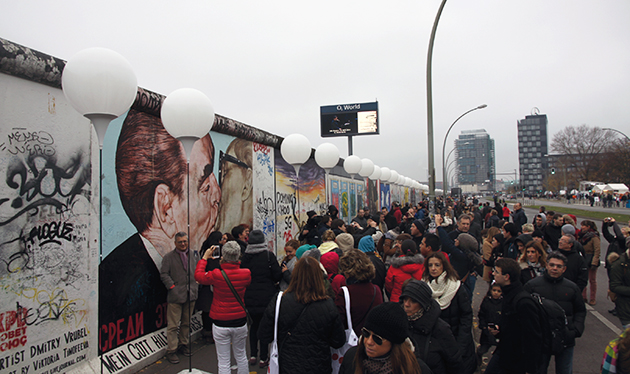
Passers-by and artists outside the East Side Gallery, built on the former site of the Berlin Wall, on the 20th anniversary of its fall. © Franck Viltart
All these sites now form part of the standard itinerary for foreign tourists, who come in increasing numbers to Berlin, Europe’s third most visited metropolis. This is something of a paradox for this “remembrance city”, where most traces of the past were either destroyed by bombs or demolished by bulldozers. Memorials and information panels are now popping up in every neighbourhood, despite each being administratively independent. In addition, the diverging viewpoints and differing powers of local actors have posed many difficulties to reaching agreement on the development of tourism to the city’s many remembrance sites. The most striking example is the blatant erasure of any trace of the city’s partition and the GDR’s legacy. Following reunification in 1990, every effort was made to remove the wall that had cut the city in two since 1961, to the point that, by the early 2000s, it was very hard to find any trace of it at all. All that remained of its 100-mile length were the 1200 metres of the East Side Gallery. It was then decided to put in place a footpath and cycle path the length of the Mauerweg. But most of its tourism development was down to private enterprise, like the famous Checkpoint Charlie, the crossing point between the American and Soviet sectors, or the DDR Museum (2006), both of which play on Ostalgie, the nostalgia for certain aspects of daily life in the former German Democratic Republic. It was not until 20 years later that the city took the reins of remembrance tourism linked to the traces of the wall, in particular with the modernisation of the Berlin Wall Memorial on Bernauer Straße, which opened in 1998, and the construction of an open-air exhibition with a vision of no man’s land around a preserved part of the wall, a visitor centre and a documentation centre. Still today, the public and private sectors share the development of tourism around the traces of the Berlin Wall. In 2019, a company called Time Ride launched bus tours that present the Berlin Wall in virtual reality using 3D glasses. The city has gradually built an identity for itself as a “remembrance city”, with its filled and empty spaces, its remembrance strata, yet where international tourists can project their own historical imaginations of the Second World War and the Cold War. An identity which the city and Land of Berlin are seeking to position in the face of considerable criticism over the way in which what to Germans is a painful and conflictual past is presented. One example is the recreation of Hohenzollern Castle on the site of the former GDR Palace of the Republic, in the heart of the city, intended to remember the city’s Prussian past.
In France, remembrance tourism emerged during the First World War; since then, the creation and development of remembrance sites has built on the interest aroused by the major anniversaries and their commemorations, as seen since the end of the First World War centenary. The development of remembrance tourism is characterised by local development and destination development projects by local organisations, which show a demand from society and a reassuring sensitivity to history. It is a phenomenon that also preserves and promotes an entire heritage, by ensuring it is passed on to as many people as possible. In comparison, Germany has difficulty in conceiving the rapport between remembrance and tourism. How remembrance and history are incorporated into public spaces should above all be concerned with civic and educational issues present in society, and guard against falling into the trap of emotion, sensationalism or any form of “positivisation” of the past. Such approaches should continue feeding into one another in the light of the democratic, European dimension of visits to these sites. A multiple perspective that reveals all the difficulties inherent to talking about shared remembrance on sites that clearly need to consider the other’s perspective.
Franck Viltart, head, Chemin des Dames Remembrance Service, Aisne Departmental Authority
Educational sites
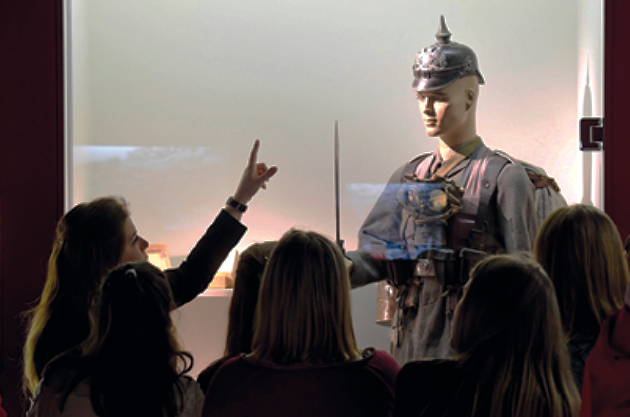
Guided tour of the Battle of Fromelles Museum: high-school students take a close look at the German uniforms. Musée de la Bataille de Fromelles/MEL ©Alexandre Traisnel
The attractiveness of remembrance sites also has to do with their ability to offer an innovative educational programme. To attract families and young children, lots of museums in France offer tours for young people and even have special areas for families with children. Teachers and schoolchildren are offered a range of different tours according to their age group – primary, secondary, lycée – as well as learning projects. School visits to many museums can now be done with the aid of digital resources, tablets or audioguides. The Caen Memorial also offers web documentaries and a multimedia site featuring child cartoon characters Rachel and Hannah, which can be used by schools to plan their visits or as a teaching resource.
Workshops are also provided on a wide variety of themes. The Musée de la Grande Guerre du Pays de Meaux for instance, offers no less than 21 different workshops for schools, which look at the First World War through comics, photography and film. The Musée de la bataille de Fromelles, on the Australian involvement in the First World War, offers a “Science and History” workshop. Not far away, the Musée de La Coupole, near Saint-Omer, has a whole programme for young people centred on science and space exploration, on this former storage and launch site for German V2 rockets, converted into a history centre and planetarium.
BerlinHistory: an app for visiting historic Berlin
An app developed by a Berlin not-for-profit organisation in partnership with the city’s museums and archives
has thousands of georeferenced photographs of Berlin, from 1933 to 1990. With the aid of a map, you can walk around the city
and find pictures of the place you are standing during the Battle of Berlin, in 1945, or the fall of the Berlin Wall, in 1989.
The app received lots of awards for digital innovation in 2020 and 2021. It is available in German and English.
Stolpersteine: remembrance stones
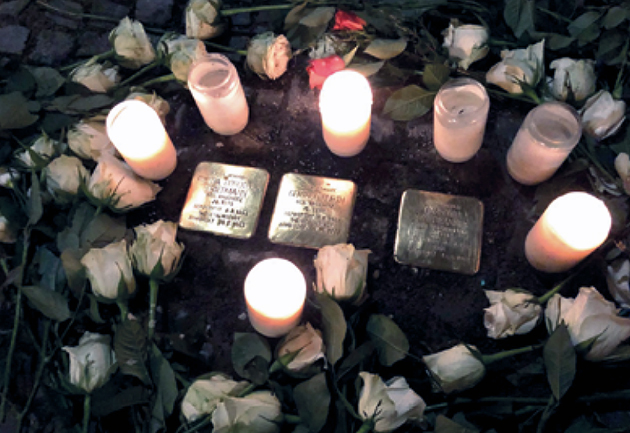
The Stolpersteine remembrance stones. © Franck Viltart
All over Berlin, it is not unusual to come across small, copper-coloured paving stones known as Stolpersteine (literally “stumbling stones”). Since 1993, artist Gunter Demnig has engraved hundreds of metal plaques with the names of victims of the Nazi regime who were persecuted, deported or murdered between 1933 and 1945, and affixed them to the paving stones of the city’s pavements. The stones are placed outside the entrance to the apartment buildings where the victims lived, as a way of honouring their memory at their last known address. Through these stones, homes, buildings and entire streets take on a whole new meaning for passers-by. Initially laid illegally, the Stolpersteine are today found across Germany and in many towns and cities of Europe and Argentina. There are nearly 7 000 in Berlin and more than 70 000 across Europe. In most cases, the request for a stone comes from the victim’s descendants or from citizens involved in remembrance work. Today, the stones offer a new form of remembrance in public spaces.
For more information, visit www.stlopersteine.eu


